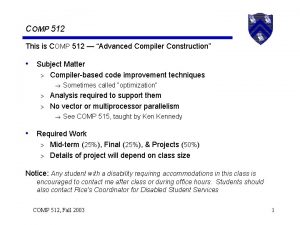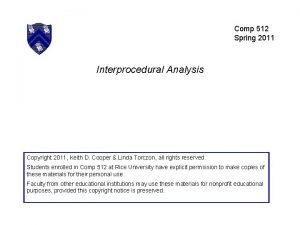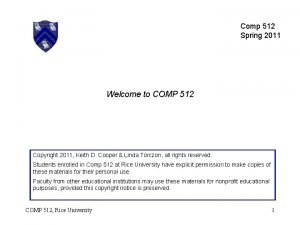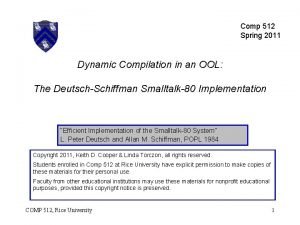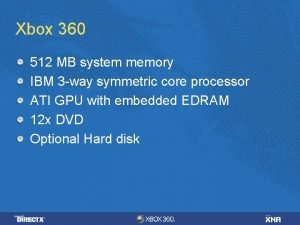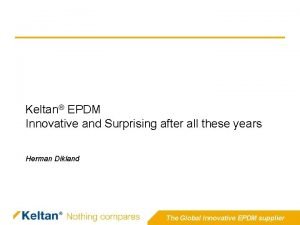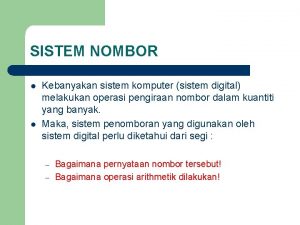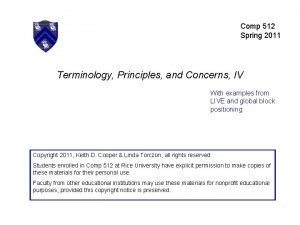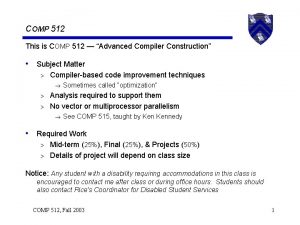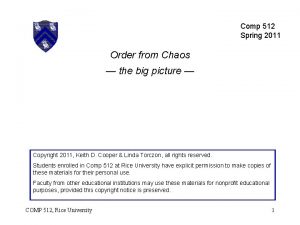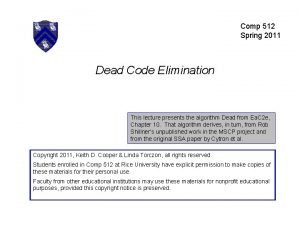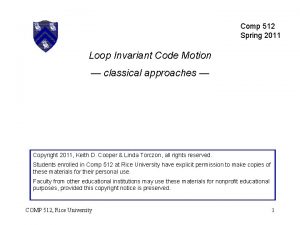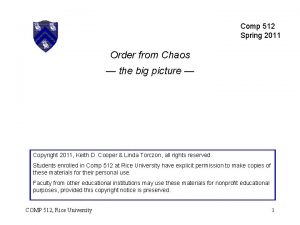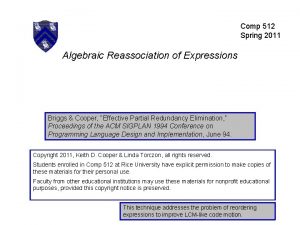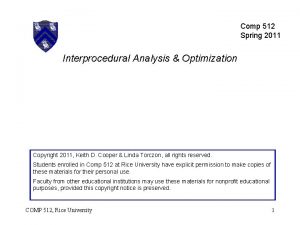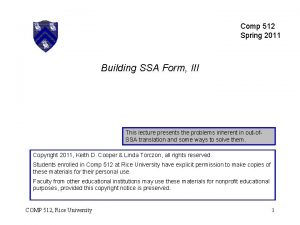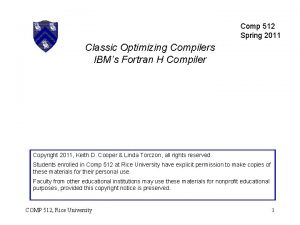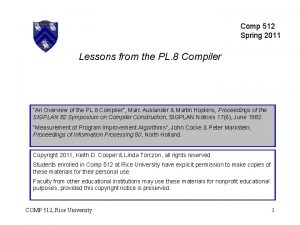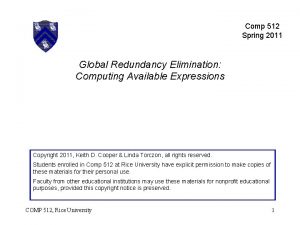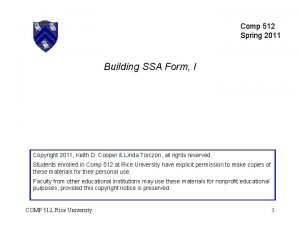Comp 512 Spring 2011 Terminology Principles and Concerns




















- Slides: 20

Comp 512 Spring 2011 Terminology, Principles, and Concerns (with examples from local value numbering) Copyright 2011, Keith D. Cooper & Linda Torczon, all rights reserved. Students enrolled in Comp 512 at Rice University have explicit permission to make copies of these materials for their personal use. Faculty from other educational institutions may use these materials for nonprofit educational purposes, provided this copyright notice is preserved.

Optimization Compilers operate at many granularities or scopes • Local techniques Work on a single basic block > Maximal length sequence of straight-line code > • Regional techniques Consider multiple blocks, but less than whole procedure > Single loop, loop nest, dominator region, … > • Intraprocedural (or global) techniques Operate on an entire procedure > Common unit of compilation > (but just one) • Interprocedural (or whole-program) techniques Operate on > 1 procedure, up to whole program > Logisitical issues related to accessing the code > COMP 512, Rice University (link time? ) 2

Optimization At each of these scopes, the compiler uses different graphs • Local techniques > Dependence graph (instruction scheduling) • Regional Techniques Control-flow graph > Dominator tree (natural loops) > • Intraprocedural (or global) techniques Control-flow graph > Def-use chains, sparse evaluation graphs, SSA as graph > • Interprocedural (or whole-program) techniques > Call (multi) graph Compiler folks must be able to perform graph traversals in their sleep – preorder, postorder, reverse postorder, … COMP 512, Rice University 3

Optimization We want to differentiate between analysis and transformation • Analysis reasons about the code’s behavior • Transformation rewrites the code to change its behavior Local techniques can interleave analysis and transformation • Property of basic block: operations execute in defined order Over larger regions, the compiler typically must complete its analysis before it transforms the code • Anaylsis must consider all possible paths, including cycles • Leads to confusion in terminology > Don’t use “optimization” for both analysis & transformation COMP 512, Rice University Rampant terminological ambiguity! 4

Redundancy Elimination as an Example An expression x+y is redundant if and only if, along every path from the procedure’s entry, it has been evaluated, and its constituent subexpressions (x & y) have not been re-defined. If the compiler can prove that an expression is redundant • It can preserve the results of earlier evaluations • It can replace the current evaluation with a reference Two pieces to the problem • Proving that x+y is redundant • Rewriting the code to eliminate the redundant evaluation One technique for accomplishing both is called value numbering COMP 512, Rice University 5

Value Numbering The key notion A 1960’s Idea ( Balke 1967 or Ershov 1954) • Assign an identifying number, V(n), to each expression V(x+y) = V(j) iff x+y and j always have the same value > Use hashing over value numbers to make it efficient > V(n) is n’s value number • Use the value numbers to “improve” the code Improving the code • Replace redundant expressions • Simplify algebraic identities • Discover constant-valued expressions, fold & propagate them • This technique was invented for low-level, linear IRs • Equivalent methods exist for trees (build a DAG, § 8. 3. 1 in Ea. C ) COMP 512, Rice University 6

Local Value Numbering Local one block at a time Block straight-line code The algorithm For each operation o in the block 1 Get value numbers for the operands from a hash lookup 2 Hash <operator, VN(o 1), VN(o 2)> to get a value number for o 3 If o already had a value number, replace o with a reference 4 If o 1 & o 2 are constant, evaluate it & use a “load immediate” If hashing behaves, the algorithm runs in linear time > If not, try multi-set discrimination Minor issues • Commutative operator hash operands in each order or sort the operands by VN before hashing (either works, sorting is cheaper ) • Looks at operand’s value number, not its name COMP 512, Rice University 7

Local Value Numbering An example Original Code a x+y b x+y a 17 c x+y With VNs a 3 x 1 + y 2 b 3 x 1 + y 2 a 4 17 c 3 x 1 + y 2 Rewritten a 3 x 1 + y 2 b 3 a 3 a 4 17 c 3 a 3 (oops!) Two redundancies: Options: • Eliminate stmts • Use c 3 b 3 • Save a 3 in t 3 • Rename around it with a • Coalesce results ? COMP 512, Rice University * 8

Local Value Numbering Example (continued) Original Code a 0 x 0 + y 0 b 0 x 0 + y 0 a 1 17 c 0 x 0 + y 0 With VNs Rewritten a 0 3 x 0 1 + y 0 2 b 0 3 x 0 1 + y 0 2 a 14 17 c 0 3 x 0 1 + y 0 2 a 0 3 x 0 1 + y 0 2 b 0 3 a 0 3 a 14 17 c 0 3 a 0 3 Renaming: Notation: Result: • Give each value a • While complex, • a 03 is available • rewriting works unique name • Makes it clear COMP 512, Rice University the meaning is clear * 9

Simple Extensions to Value Numbering Constant folding • • Add a bit that records when a value is constant Evaluate constant values at compile-time Replace with load immediate or immediate operand No stronger local algorithm Algebraic identities Identities: • Must check (many) special cases • Replace result with input VN • Build a decision tree on operation x y, x+0, x-0, x 1, x÷ 1, x-x, x 0, x 0 x. FF…FF, max(x, MAXINT), min(x, MININT), max(x, x), min(y, y), and so on. . . COMP 512, Rice University (Click) (over values, not names ) 10

Optimization Should think about these issues with every transformation In discussing any optimization, look for three issues Safety – Does it change the results of the computation? • Safety is proven with results of analysis • Data-flow analysis or other special case analysis Profitability – Is it expected to speed up execution? • Many authors assume transformations are always profitable • Use either heuristics or a careful algebra of costs Opportunity – Can we efficiently locate places to apply it? • Can we find all the places where the transformation works? • Do we need to update safety information afterward? COMP 512, Rice University * 11

Safety The first principle of optimization The compiler must preserve the code’s “meaning” When can the compiler transform the code? • Original & transformed code must have the same final state • Variables that are visible at exit • Equality of result, not equality of method (ignore temporaries) Formal notion For two expressions, M and N, we say that M and N are observationally equivalent if and only if, in any context C where both M and N are closed (that is, have no free variables), evaluating C[M] and C[N] either produces identical results or neither terminates. Plotkin, 1975 Different translations with identical results are fine COMP 512, Rice University 12

Safety In practice, compilers use a simpler notion of equivalence If, in their actual program context, the result of evaluating e’ cannot be distinguished from the result of evaluating e, the compiler can substitute e’ for e. • This restatement ignores divergence • If e’ is faster than e, the transformation is profitable Equivalence and context • Compiled code always executes in some context • Optimization is the art of capitalizing on context • Lack of context fully general (i. e. , slow) code Some compilers employ a worse standard (F ORTRAN) • Correct behavior for “standard conforming” code • Undefined behavior for other code COMP 512, Rice University 13

Like N. Wirth? Safety My favorite bad quote on safety You, as a compiler writer, must decide if it’s worth the risk of doing this kind of optimization. It’s difficult for the compiler to distinguish between the safe and dangerous cases, here. For example, many C compilers perform risky optimizations because the compiler writer has assumed that a C programmer can understand the problems and take steps to remedy them at the source code level. It’s better to provide the maximum optimization, even if it’s dangerous, than to be conservative at the cost of less efficient code. A Pascal programmer may not have the same level of sophistication as a C programmer, however, so the better choice in this situation might be to avoid the risky optimization entirely or to require a special command-line switch to enable the optimization. Allen Holub, Compiler Design in C, Prentice Hall, 1990, p. 677 The point Gone in second edition • You must not violate the first principle • Without the first principle, just compile a return and be done COMP 512, Rice University * 14

Safety & Value Numbering Why is local value numbering safe? • Hash table starts empty • Expressions placed in table as processed • If <operator, VN(o 1), VN(o 2)> is in the table, then Critical property of a basic block: If any statement executes, they all execute, in a predetermined order It has already occurred at least once in the block > Neither o 1 nor o 2 have been subsequently redefined > The mapping uses VN(o 1) and VN(o 2), not o 1 and o 2 ® If one was redefined, it would have a new VN ® If <operator, VN(o 1), VN(o 2)> has a VN, the compiler can safely use it • Algorithm incrementally constructs a proof that <operator, VN(o 1), VN(o 2)> is redundant • Algorithm modifies the code, but does not invalidate the table COMP 512, Rice University 15

Profitability The compiler should only transform the code when it helps! • Eliminating one or more operations • Replacing an operation with a cheaper one • Moving an operation to a place where it will execute fewer times Sometimes, we can prove profitability > Fold a constant expression into an immediate operation Sometimes, we must guess > Eliminating a redundant operation in a loop Sometimes, we cannot tell … > Inlining in a Fortran compiler Compiler writers should know when they cannot tell if some transformation is profitable ! We need to consider the issue explicitly. . . COMP 512, Rice University * 16

Profitability & Value Numbering When is local value numbering profitable? • If reuse is cheaper than re-computation Does not cause a spill or a copy > In practice, assumed to be true > (hard to determine) • Local constant folding is always profitable Re-computing uses a register, as does load immediate > Immediate form of operation avoids even that cost > • Algebraic identities If it eliminates an operation, it is profitable ( x + 0) > Profitability of simplification depends on target (2 x x+x) > Easy to factor target machine costs into the implementation ® (don’t do the unprofitable ones! ) > COMP 512, Rice University 17

Opportunity To perform an optimization, the compiler must locate all the places in the code where it can be applied • Allows compiler to evaluate each possible application • Leads to efficient application of the transformation • Avoids additional search Approaches • Perform analysis to find opportunities > VERYBUSY expressions & code hoisting • Look at every operation > Value numbering, loop invariant code motion • Iterate over subset of the IR > Operator strength reduction on SSA COMP 512, Rice University 18

Opportunity & Value Numbering How does local value numbering find opportunity? • Linear scan over block, in execution order • Constructs a model of program state • At each operation, check for several opportunities Summary • It performs an exhaustive search of the opportunities • This answer is not satisfying, but it is true Must limit cost of checking each operation > For example, use a tree of algebraic identities by operator > • Hashing keeps cost down to O(1) per operand + per operation COMP 512, Rice University 19

Next Class Value numbering over larger scopes, and the beginnings of data-flow analysis > Chapters 8 and 9 of Ea. C 2 e COMP 512, Rice University 20
 Comp 512
Comp 512 Comp 512
Comp 512 Comp 512
Comp 512 Comp 512
Comp 512 Spring, summer, fall, winter... and spring (2003)
Spring, summer, fall, winter... and spring (2003) Months in the spring
Months in the spring Ecisd spring break 2011
Ecisd spring break 2011 Addressing concerns and earning commitment
Addressing concerns and earning commitment Earning commitment
Earning commitment Joys and concerns
Joys and concerns Joys and concerns prayer
Joys and concerns prayer Joys and concerns images
Joys and concerns images 360/512
360/512 Dts 500 gate motor problems
Dts 500 gate motor problems Stanley pac software
Stanley pac software Pac 512
Pac 512 Herman dikland
Herman dikland 2560/512
2560/512 Nombor dua desimal
Nombor dua desimal What is 3 512?
What is 3 512? 1024/16000
1024/16000
